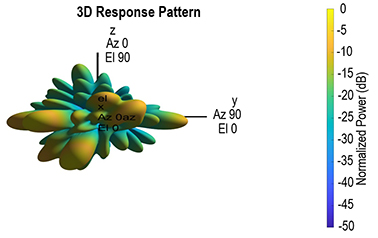
Numerical Simulation of the Hybrid Precoding Algorithm in Millimeter Wave Band Using the Open Source Channel Model
https://doi.org/10.31854/1813-324X-2025-11-1-18-25
EDN: IZZZMV
Abstract
Relevance. The use of multi-antenna technologies in the form of signal precoding is a basic condition for increasing spectral efficiency in modern mobile communication systems in combination with the transition to the millimeter wave frequency band. Propagation conditions in the millimeter wave require the use of antenna arrays in communication systems to compensate for propagation losses and directional transmission and reception of user signals. When transmitting multiple parallel spatial user data streams, signal precoding is used to implement spatial multiplexing and improve the spectral efficiency of the system. A hybrid architecture for constructing a multi-antenna system and precoding, consisting of analog and digital parts, is considered. But reducing the number of radio frequency paths leads to a decrease in the possibility of spatial multiplexing compared to a completely digital system. In this regard, it is important to select the optimal number of radio frequency paths to obtain maximum spatial multiplexing, taking into account the current conditions of signal propagation and spatial correlation of the communication channel.
The purpose of the study is to determine the effect on the spectral efficiency of the choice of the number of used radio frequency paths in a hybrid precoding system.
The research methods consist of simulation modeling of a hybrid precoding algorithm. To solve the problem of numerical modeling of hybrid precoding, implementations of a MIMO channel of millimeter waves are used, obtained using the open channel model software package QuaDRiGa.
The results are presented in the form of distribution functions of the spectral efficiency of the hybrid precoding system, obtained on the basis of channel implementations in a certain propagation scenario.
The novelty lies in the numerical determination of the channel parameters of a multi-antenna communication system in the millimeter range and the use of the distribution of eigenvalues of the obtained channel implementations to study the influence of the number of radio frequency paths on the spectral efficiency of a communication system with hybrid precoding achievable under given conditions.
About the Authors
A. A. KalachikovRussian Federation
S. L. Remizov
Russian Federation
I. I. Rezvan
Russian Federation
References
1. Roh W., Seol J.Y., Park J., Lee B, Lee J., Yungsoo K. Millimeter-wave beamforming as an enabling technology for 5G cellular communications: Theoretical feasibility and prototype results. IEEE Communications Magazine. 2014;52(2):106‒113. DOI:10.1109/MCOM.2014.6736750
2. Molisch A.F., Ratnam V.V., Han S., Li Z., Nguyen S.L.H. Hybrid Beamforming for Massive MIMO: A survey. IEEE Communications Magazine. 2017;55(9):134‒141. DOI:10.1109/MCOM.2017.1600400
3. Nosov V.I. Methods of Increasing the Noise Immunity of Radio Communication Systems Using MIMO Technology and Space-Time Signal Processing. Novosibirsk: Siberian State University of Telecommunications and Informatics Publ.; 2014. 316 p. (in Russ.) EDN:VRTAXT
4. Sun S., Rappaport T.S., Shafi M., Tang P., Zhang J., Smith P.J. Propagation Models and Performance Evaluation for 5G Millimeter-Wave Bands. IEEE Transactions on Vehicular Technology. 2018;67(9):8422‒8439. DOI:10.1109/TVT.2018.2848208. EDN:YIPMFV
5. El Ayach O., Rajagopal S., Abu-Surra S., Pi Z., Jr. Heath R.W. Spatially Sparse Precoding in Millimeter Wave MIMO Systems. IEEE Transactions on Wireless Communications. 2014;13(3):1499‒1513. DOI:10.1109/TWC.2014.011714.130846
6. Heath R.W., Gonzalez-Prelcic N., Rangan S., Roh W., Sayeed A.M. An Overview of Signal Processing Techniques for Millimeter Wave MIMO Systems. IEEE Journal of Selected Topics in Signal Processing. 2016;10(3):436‒453. DOI:10.1109/JSTSP.2016.2523924.
7. Rappaport T.S., Gutierrez F., Ben-Dor E., Murdock J.N., Qiao Y., Tamir J.I. Broadband Millimeter-Wave Propagation Measurements and Models Using Adaptive-Beam Antennas for Outdoor Urban Cellular Communications. IEEE Transactions on Antennas and Propagation. 2013;61(4):1850‒1859. DOI:10.1109/TAP.2012.2235056
8. Sohrabi F., Yu W., Hybrid digital and analog beamforming design for large-scale antenna arrays. IEEE Journal of Selected Topics in Signal Processing. 2016;10(3):501–513. DOI:10.1109/JSTSP.2016.2520912
9. Payami S., Ghoraishi M., Dianati M. Hybrid beamforming for large antenna arrays with phase shifter selection. IEEE Transactions on Wireless Communications. 2016:15(11):7258–7271. DOI:10.1109/TWC.2016.2599526
10. Jaeckel S., Raschkowski L., Boerner K., Thiele L. QuaDRiGa: A 3-D Multicell Channel Model with Time Evolution for Enabling Virtual Field Trials. IEEE Transactions on Antennas Propagation. 2013;62(6):3242‒3256. DOI:10.1109/TAP.2014.2310220
11. Jaeckel S., Raschkowski L., Boerner K., Thiele L., Burkhardt F., Eberlein E. QuaDRiGa ‒ Quasi Deterministic Radio Channel Generator. User Manual and Documentation. Tech. Rep. v2.2.0. Berlin: Fraunhofer Heinrich Hertz Institute; 2019.
Review
For citations:
Kalachikov A.A., Remizov S.L., Rezvan I.I. Numerical Simulation of the Hybrid Precoding Algorithm in Millimeter Wave Band Using the Open Source Channel Model. Proceedings of Telecommunication Universities. 2025;11(1):18-25. (In Russ.) https://doi.org/10.31854/1813-324X-2025-11-1-18-25. EDN: IZZZMV


































